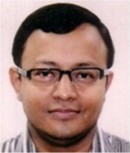
Plenary Lecture
Stochastic MIMO Channel Modelling Using Split-ANFIS Framework With GA Optimization

Professor Kandarpa Kumar Sarma
Department of Electronics and Communication Technology
Gauhati University
Assam, India
E-mail: kandarpaks@gmail.com
Abstract: Multiple input multiple output (MIMO) wireless technology has been accepted as the backbone of ever expanding, high data rate mobile communication networks despite its channel estimation offering considerable challenges. MIMO channel is full of uncertainty and random behaviour due to interference and correlation among propagation paths and related variations. Though traditional methods of modelling the MIMO channels have already proven their worth, soft-computational approaches can be appended to this list of techniques already known. The primary consideration behind such a possibility is the fact that soft-computational techniques due to their abilities to learn from the environment can use the knowledge acquired for subsequent processing. Here, we propose such an approach based on fuzzy systems and recurrent neural network (RNN). Fuzzy systems are useful for modelling uncertainty, provide expert-level decision making and are also capable of tracking subtle variations in the applied patterns. These attributes make them suitable options for applications with MIMO channel modelling. RNN is a form of feed-forward artificial neural network (ANN) which due to the presence of multiple feedback loops can track time-dependent variations in input patterns. These considerations catalyze the formation of a hybrid set-up formed as an adaptive neuro-fuzzy inference system (ANFIS) constituted by fuzzified RNN (FRNN) blocks so as to model MIMO channel characteristics. The proposed architecture has two ANFIS blocks to deal with in-phase and quadrature components of received signal separately. The output of these two split-ANFIS blocks are combined by a Self Organizing Map (SOM) which generates the most suitable form of the predicted output. During the fuzzification stage, a genetic algorithm (GA) based optimizer is used to select the best set of parameters (centre, slop and spread) for the bell-membership function considered. The GA assisted fuzzification adds to the precision of the system. Each of the FRNN blocks receives a Kalman Filter estimated copy of the immediately next form of the received signal which is used as reference during the short training phase. The experimental results derived show superior ability of such an architecture compared to traditional approaches with lower bit error rate (BER) values and processing speed while generating greater precision during recovery of transmitted data through severely faded MIMO channels. The suggested system can be a part of upcoming adaptive receiver models optimized for high data rate systems.
Brief Biography of the Speaker: Kandarpa Kumar Sarma currently is with the Department of Electronics and Communication Technology, Gauhati University, Guwahati, India as Assistant Professor with around 16 years of teaching experience. He has completed MSc in Electronics from Gauhati University in 1997. He also completed MTech in Signal Processing from IIT Guwahati, Guwahati, India in 2005 with specialization in Soft-computation and Pattern Recognition. Later, he completed PhD from IIT Guwahati in 2011 in the area of Mobile Communication and Soft-Computation.
He has authored five books, ten book chapters, 91 journal and 132 conference proceedings papers. He has attended about twenty two national and international conferences and have been reviewer of several international journals and around fifty international/national conferences. He also serve as guest editor of two Interscience journals namely IJICT and IJCVR.
His areas of interest are Soft-Computation and its applications, Mobile Communication, Antenna Design, Speech Processing, Document Image Analysis and Signal Processing applications in High Energy Physics, Neuro-computing and Computational Models for Social-Science Applications.
He is a senior member of IEEE. He is also a life member of CSI (India), IETE (India), ISTE (India), Instrument Society of India and Assam Science Society. He is also the Placement Officer of Gauhati University since 2006. Presently he is also the HoD ic of a new department named Electronics and Communication Engineering started from 2009 under Faculty of Technology offering BTech and MTech programmes of Gauhati University which is the largest institution of higher education in the north-eastern part of India.